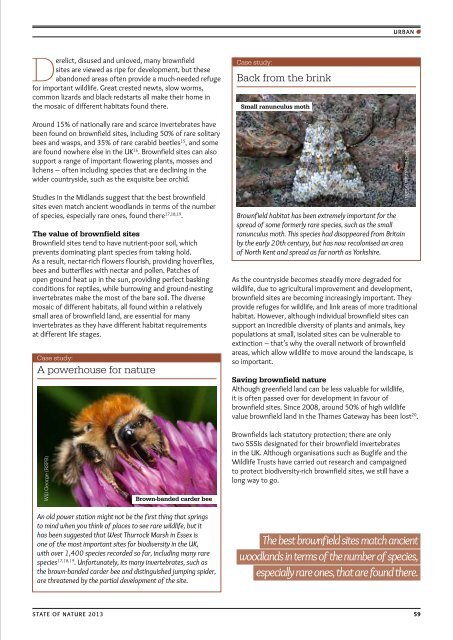State of Nature report - RSPB
State of Nature report - RSPB
State of Nature report - RSPB
Create successful ePaper yourself
Turn your PDF publications into a flip-book with our unique Google optimized e-Paper software.
URBAN<br />
Derelict, disused and unloved, many brownfield<br />
sites are viewed as ripe for development, but these<br />
abandoned areas <strong>of</strong>ten provide a much-needed refuge<br />
for important wildlife. Great crested newts, slow worms,<br />
common lizards and black redstarts all make their home in<br />
the mosaic <strong>of</strong> different habitats found there.<br />
Around 15% <strong>of</strong> nationally rare and scarce invertebrates have<br />
been found on brownfield sites, including 50% <strong>of</strong> rare solitary<br />
bees and wasps, and 35% <strong>of</strong> rare carabid beetles 15 , and some<br />
are found nowhere else in the UK 16 . Brownfield sites can also<br />
support a range <strong>of</strong> important flowering plants, mosses and<br />
lichens – <strong>of</strong>ten including species that are declining in the<br />
wider countryside, such as the exquisite bee orchid.<br />
Studies in the Midlands suggest that the best brownfield<br />
sites even match ancient woodlands in terms <strong>of</strong> the number<br />
<strong>of</strong> species, especially rare ones, found there 17,18,19 .<br />
The value <strong>of</strong> brownfield sites<br />
Brownfield sites tend to have nutrient-poor soil, which<br />
prevents dominating plant species from taking hold.<br />
As a result, nectar-rich flowers flourish, providing hoverflies,<br />
bees and butterflies with nectar and pollen. Patches <strong>of</strong><br />
open ground heat up in the sun, providing perfect basking<br />
conditions for reptiles, while burrowing and ground-nesting<br />
invertebrates make the most <strong>of</strong> the bare soil. The diverse<br />
mosaic <strong>of</strong> different habitats, all found within a relatively<br />
small area <strong>of</strong> brownfield land, are essential for many<br />
invertebrates as they have different habitat requirements<br />
at different life stages.<br />
Case study:<br />
A powerhouse for nature<br />
Case study:<br />
Back from the brink<br />
Small ranunculus moth<br />
Brownfield habitat has been extremely important for the<br />
spread <strong>of</strong> some formerly rare species, such as the small<br />
ranunculus moth. This species had disappeared from Britain<br />
by the early 20th century, but has now recolonised an area<br />
<strong>of</strong> North Kent and spread as far north as Yorkshire.<br />
As the countryside becomes steadily more degraded for<br />
wildlife, due to agricultural improvement and development,<br />
brownfield sites are becoming increasingly important. They<br />
provide refuges for wildlife, and link areas <strong>of</strong> more traditional<br />
habitat. However, although individual brownfield sites can<br />
support an incredible diversity <strong>of</strong> plants and animals, key<br />
populations at small, isolated sites can be vulnerable to<br />
extinction – that’s why the overall network <strong>of</strong> brownfield<br />
areas, which allow wildlife to move around the landscape, is<br />
so important.<br />
Saving brownfield nature<br />
Although greenfield land can be less valuable for wildlife,<br />
it is <strong>of</strong>ten passed over for development in favour <strong>of</strong><br />
brownfield sites. Since 2008, around 50% <strong>of</strong> high wildlife<br />
value brownfield land in the Thames Gateway has been lost 20 .<br />
Neil Bowman (FLPA)<br />
Will George (<strong>RSPB</strong>)<br />
Brown-banded carder bee<br />
Brownfields lack statutory protection; there are only<br />
two SSSIs designated for their brownfield invertebrates<br />
in the UK. Although organisations such as Buglife and the<br />
Wildlife Trusts have carried out research and campaigned<br />
to protect biodiversity-rich brownfield sites, we still have a<br />
long way to go.<br />
An old power station might not be the first thing that springs<br />
to mind when you think <strong>of</strong> places to see rare wildlife, but it<br />
has been suggested that West Thurrock Marsh in Essex is<br />
one <strong>of</strong> the most important sites for biodiversity in the UK,<br />
with over 1,400 species recorded so far, including many rare<br />
species 17,18,19 . Unfortunately, its many invertebrates, such as<br />
the brown-banded carder bee and distinguished jumping spider,<br />
are threatened by the partial development <strong>of</strong> the site.<br />
The best brownfield sites match ancient<br />
woodlands in terms <strong>of</strong> the number <strong>of</strong> species,<br />
especially rare ones, that are found there.<br />
STATE OF NATURE 2013 59

















